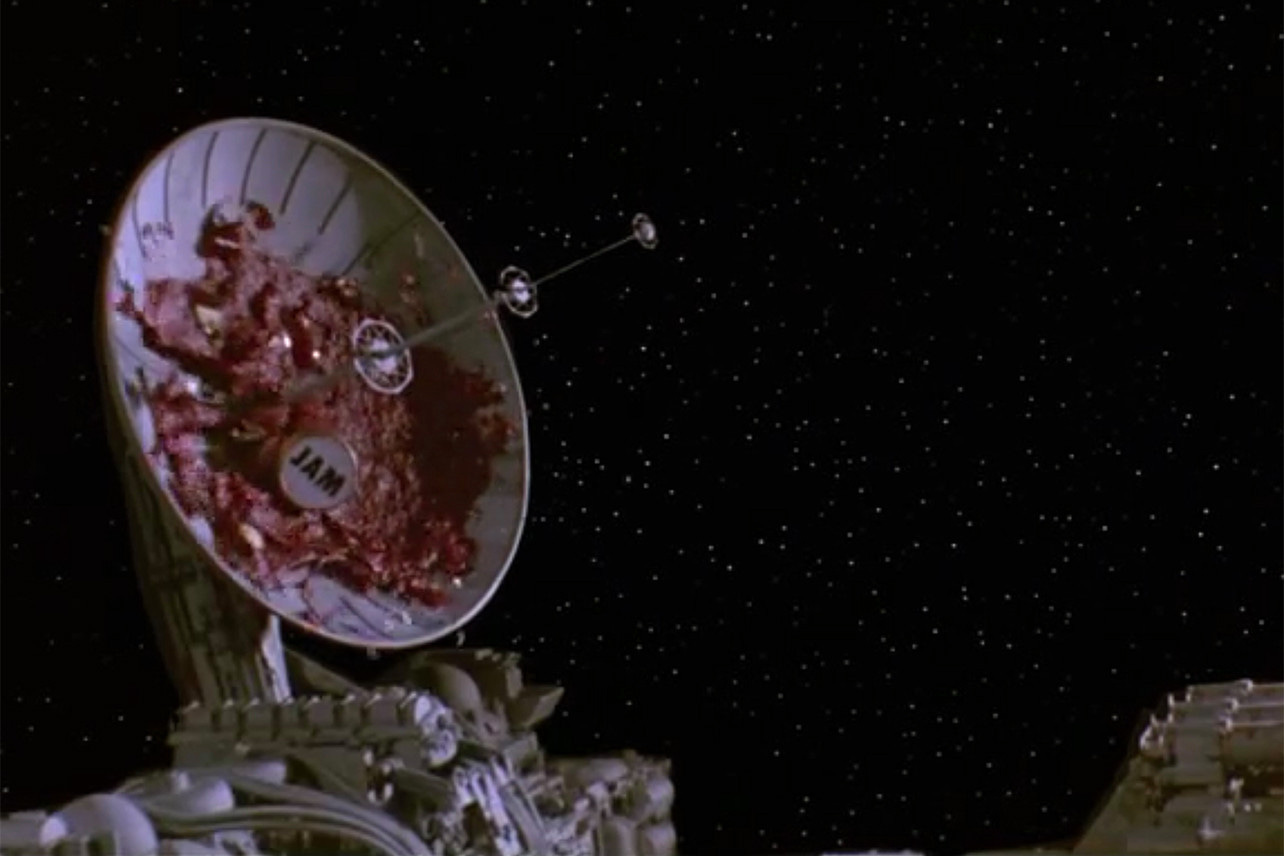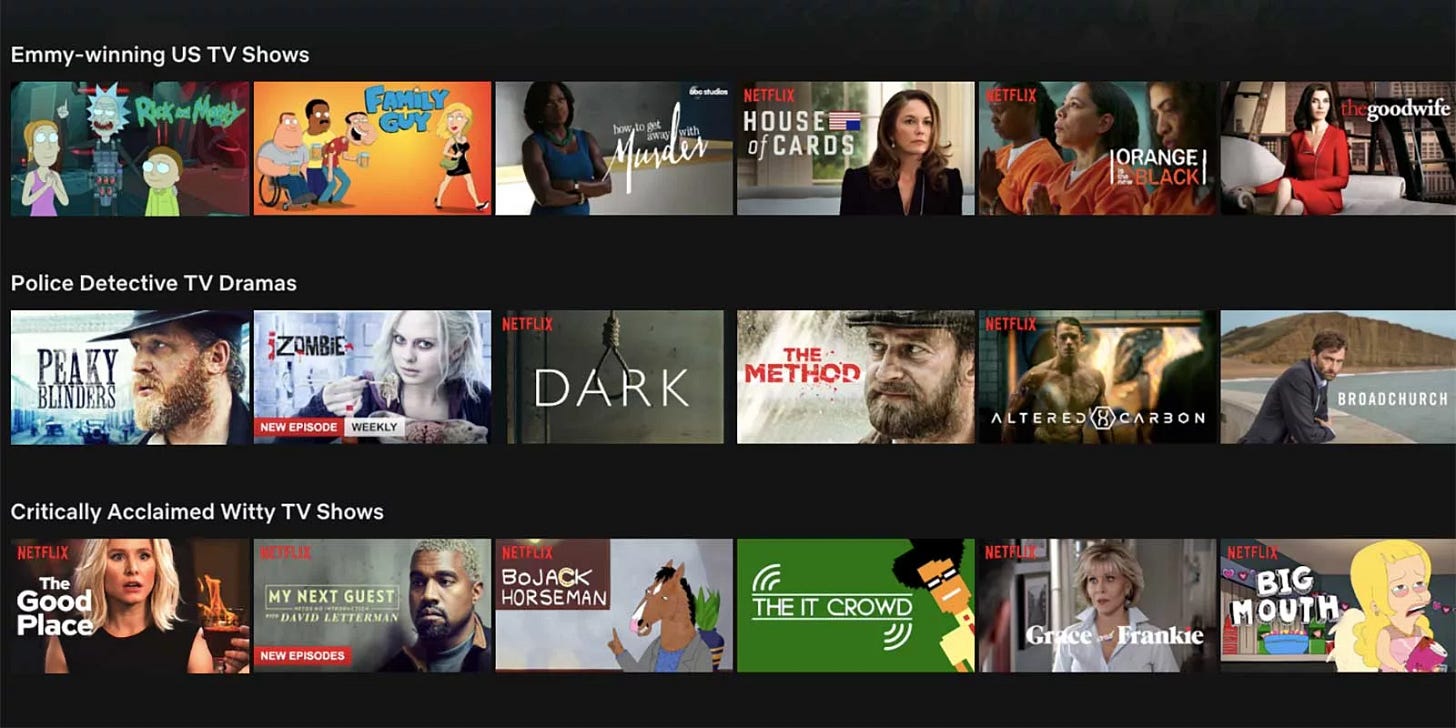Discovery: A Netflix Challenge
Netflix has thousands of titles. Why do you keep watching The Office?
Welcome back to Entertainment + Tech. Each week will cover an interesting way technology & entertainment are colliding and where things might go from here.
New to the newsletter? Subscribe here:
At Google, one of my roles was product lead for Google Play Movies & TV’s Search & Discovery team. If you picture the whole product as a Blockbuster, we were the ones arranging movies on the shelves. We were the teenage employees giving you suggestions.
I loved the product. My job was to think about movies, how people made sense of them, and how to get them to movies they’d enjoy.
The search part was mostly easy–if someone was searching for Frozen, we gave them Frozen. [1]
Discovery was harder. (Since most of you probably haven’t used Google Play, I’ll talk about it in the context of Netflix. The same principles apply, mostly. [2])
Discovery
With discovery, the user comes in not knowing what they want. The specificity of their intent can vary, e.g. “I want an action movie” vs. “I just want to watch something”. To truly help someone discover something, you have to find the right title, at the right time, for them. To make it easier, most products present the user a choice of a bunch of recommendations.
There’s a problem with choice, though. If we’re naive, we might assume that users have some hidden preference, and the more options we show them, the more likely they are to find the thing that matches it.
In reality, something different happens.
Jammed

Back in 2000, Sheena Iyengar & Mark Lepper ran some seemingly simple studies on choice. In one, shoppers at a grocery store were presented with a sample booth for jam. [3] They were allowed to sample as many flavors as they liked, and then they were then given a coupon for a dollar off any of the jams. The experiment had two variants: one day the booth offered 6 flavors of jam, the next day, 24.
Our naive assumption above would say that people would be more likely to buy when presented with 24 jams, since they’re more likely to find the flavor that matches their tastes. Obviously, as I’ve been hinting this whole time, that wasn’t the case. People were actually 10x more likely to buy jam when only shown 6 flavor samples. What’s going on here?
It turns out a large number of choices can overload people. When people have lots of options, they have trouble deciding between them. When the options are similar or difficult to reason about (“how good is this movie I haven’t seen?”), it gets harder. People get overwhelmed fairly easily, and then they simplify. They might leave, or they might go with a default option–with The Office, you know what you’re getting. [4]
The Netflix Fix
To deal with this overload, Netflix tries a couple different approaches within the product.
As one example, Netflix provides a visual hierarchy to reduce the number of decisions. They organize everything into rows, so you quickly decide whether or not you want a “Quirky Animated Comedy”.

As another, in the details for individual titles, they add nudges to explain why you might like it. A common one is pointing out notable talent or awards for the title.

However, I think there’s an even more powerful trick Netflix uses to make its recommendations work.
The Secret
Ask a good product manager how to fix a problem, and they’ll find features they can build. Ask a great product manager, and they’ll work with the whole ecosystem around the product. Netflix doesn’t just exist on your TV or on your phone, and their recommendations aren’t just an ML model.
Netflix uses marketing and word of mouth heavily, and that’s an important tool. When everyone logged into Netflix at the beginning of quarantine and Tiger King was recommended to them, they didn’t choose to watch because it was a perfectly tailored suggestion just for them. They watched because everyone else was talking about it already. It was easy to default to watching it.
This isn’t to denigrate Netflix’s efforts in recommendation models. It’s a hard problem that they put great work into. The point is that rather than having to convince the user entirely within the limited & crowded home page, when they’re already overloaded, Netflix can also do a lot of that work out in the real world. In the moment, it becomes easier for the user to make that choice. [5] An avenue for in-product recommendation success, then, is predicting which titles the user has heard about. They can work together to make recommendations more effective. Even for titles that are less hot, the perception the user has already formed will be important.
Ready Player One?
If you have a platform that can’t rely on these kind of extra-product influences, it’s a harder road. Considering the impact of how choices are presented to the user is critical.
One thing I’m surprised I haven’t seen more of: interactive recommendations. I suspect if you give users a short set of meaningful choices to help them narrow down their options, you could get pretty good results while keeping the user engaged.
Even better, choices can shape preferences. If you ask users what they’re looking for, and they pick action movies, they’re probably more interested in action movies than they were a minute ago.
I know Steam released a tool in this vein, but haven’t seen others. Maybe they’ve been tried, and the results were poor. If anyone knows any streaming platform that’s given it a shot, let me know!
———
[1] Technically, I’m talking what we call navigational search. There are categorical searches like “comedy movies” that I’ll lump under discovery here, because the user’s intent is to discover something they didn’t know they wanted.
[2] One notable difference: Netflix’s subscription model means watching any individual title is marginally free, so there’s a lower barrier to getting someone to try something. Discovery is still hard overall, though.
[3] That’s an HBR summary. Here’s the original paper
[4] In the jam study, they removed options like strawberry from both conditions because they expected it to be a familiar flavor they would already have a preference for.
[5] If you’re a faithful reader, you’ll remember me making a related point in my issue about Quibi. Presumably, this is one of the reasons marketing exists in the first place.
A Couple Links
🎵A great, quick thread on how TikTok duets are changing music
Not my area of expertise, but a question I wonder about: part of the communication process between artists must include rights & payments. If someone makes a Duet banger, I imagine it can’t just go on Spotify. How do they go about monetizing it fairly?
🎇The live Mulan remake got down to (big) business
It brought in additional revenue from existing subscribers & seems to have driven new subscribers to the platform. I expect to see more Disney+ releases with the model. With theatrical windows already under attack and the repeal of the Paramount Decrees (basically, they said studios couldn’t own theater chains), theaters are in for a bumpy ride.
🤖The power of AI tools on glorious display
Like I discussed last issue, humans & AI will collaborate to create true beauty.
Simple Favors
I’m almost two months into writing this newsletter now, and it’s been a blast. I love talking about entertainment & tech, and it’s led me to a lot of interesting people already.
Now that I’ve got the basic gist of this newsletter thing, I’ve set a couple goals and could use your help (inspired by Packy McCormick at Not Boring):
Grow to 1000 Subscribers by the New Year
One of the best things about this newsletter is how it’s connected me to new people and interesting ideas. More subscribers means more serendipity, and it’ll help me learn and find cool new topics to talk to you about. I also love the space and want to get more people thinking about what’s possible here.
As a peek behind the curtain, I currently have ~150 subscribers. It’s ambitious, but I want to grow the list to 1000 subs by the end of the year. I’m new to this whole game and trying out different things to grow my audience. If you’ve got advice on that, I’d love to hear it.
Also, if you think you know someone who’d be into this newsletter, I’m humbly asking you to share it with them:
Get Feedback from the Readership
I’m putting this newsletter together based on my intuition and what I’ve seen elsewhere, but as a PM, I’d love to know what my users think.
I get a handful of responses to each issue, but if you read this and have any thoughts at all, even half-formed ones, I want to hear from you. What’s a topic you think is cool? What do you think I’ve missed? What can I do to make it more interesting to you? How can I get communication back from my audience, more often?
Any thoughts you send now could improve every single future issue. That’s some scalable impact right there.
Find More Cool People & Companies to Talk To
As I mentioned, I’ve started setting up interviews with some folks in the space. I plan to release the first next week, and it should be a fun one. If you know anyone who’d be an interesting subject, let me know!
I also want to start setting up guest posts and collaborations. If you know someone who’d be interested (or you are), reach out!
Thank You

This has been a great ride so far, and I‘m just getting started. The support from family, friends, and strangers has been huge. Thanks for being part of the journey.
I’d love to hear your feedback and ideas, especially for the three goals I listed above. You can respond to this email or reach out to me on LinkedIn.



